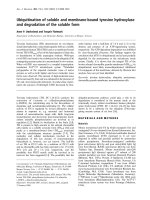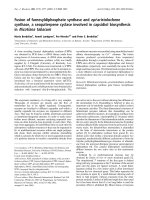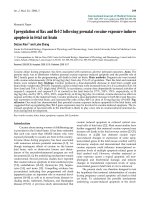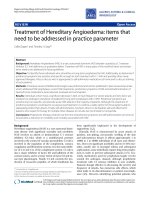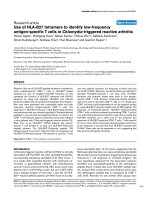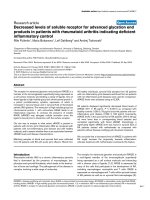Báo cáo y học: "Use of soluble MHC class II/peptide multimers to detect antigen-specific T cells in human disease." pps
Bạn đang xem bản rút gọn của tài liệu. Xem và tải ngay bản đầy đủ của tài liệu tại đây (48.72 KB, 5 trang )
261
CFSE = 5-carboxyfluorescein diacetate succinimidyl ester; gp39 = cartilage glycoprotein 39; MHC = major histocompatibility complex; TCR =
T-cell receptor.
Available online />Background
CD4
+
and CD8
+
T cells, through their T-cell receptors
(TCRs), recognize peptides bound to MHC class II and
class I molecules, respectively. The peptide, derived from
the protein antigen, and the restricting MHC molecule are
both critical for specific binding of the TCR. Until recently,
the identification or quantitation of antigen-specific T cells
was possible only by assaying for their function. Classically,
a population of T cells was cocultured with antigen and
antigen presenting cells, which express surface MHC mol-
ecules. Several days later, tritiated thymidine was added to
the culture and antigen-induced T-cell proliferation was
quantitated by the amount of incorporated thymidine. Modi-
fications of this basic antigen-stimulation technique include
plating the cells at limiting dilution and counting the
number of T-cell clones that are generated (limiting dilution
analysis). T cells can also be stimulated with antigen in
vitro and assayed for cytokine production either in bulk cul-
tures or by enumerating individual cytokine-producing cells.
These methods probably underestimate the true number of
antigen-reactive T cells since some cells cannot proliferate
or make the particular cytokines being measured.
Attempts to isolate and study antigen-specific T cells after
a functional response (e.g. proliferation) in bulk culture or
after cloning can also be problematic. For example, the
TCR repertoire of responding cells can be remarkably
altered compared with the starting population, and T-cell
function is frequently changed by the in vitro response.
Furthermore, some T cells are not able to proliferate in
culture or die in culture after stimulation. Examples include
expanded CD8
+
T-cell clones in the circulation of older
individuals, expanded CD4
+
T-cell clones in the synovial
fluid of patients with rheumatoid arthritis, and CD4
+
T cells
in patients with systemic lupus erythematosus.
The development of fluorescently labeled MHC/peptide
staining reagents now permits direct detection and isola-
tion of antigen-specific T cells, independent of cellular
function. The preparation and use of MHC class I/peptide
multimers to study antigen-specific CD8
+
T cells was
recently reviewed in this journal [1]. We now review the
development of MHC class II/peptide multimers as a
research tool.
Perspective (what it can do)
A single soluble MHC/peptide complex binds to a specific
TCR with low affinity, usually with dissociation constants no
better than 1–100 µM. The weak binding to TCR and fast
dissociation prevents these molecules from being useful
Review
Use of soluble MHC class II/peptide multimers to detect
antigen-specific T cells in human disease
Jerome R Bill and Brian L Kotzin
Departments of Medicine and Immunology, University of Colorado Health Sciences Center and National Jewish Medical and Research Center, Denver,
Colorado, USA
Corresponding author: Jerome R Bill (e-mail: )
Received: 20 November 2001 Revisions received: 1 February 2002 Accepted: 6 February 2002 Published: 28 February 2002
Arthritis Res 2002, 4:261-265
© 2002 BioMed Central Ltd (
Print ISSN 1465-9905; Online ISSN 1465-9913)
Abstract
Most techniques that identify antigen-specific T cells are dependent on the response of these cells to
the relevant antigen in culture. Soluble multimers of MHC molecules, when occupied with the same
peptide, will bind selectively to T cells specific for that MHC/peptide complex. Techniques to produce
fluorescent MHC class II/peptide multimers have recently been developed. These reagents provide a
method to facilitate detection and isolation of antigen-specific CD4
+
T cells and they represent a new
research tool to study these cells in patients with immune-mediated diseases.
Keywords: flow cytometry, MHC class II, MHC/peptide multimer, T cell, T-cell receptor
262
Arthritis Research Vol 4 No 4 Bill and Kotzin
reagents to detect peptide-specific T cells. However,
several studies have shown that when soluble MHC/
peptide complexes are multimerized, they can achieve much
higher avidity for the TCR on the T-cell surface, presumably
via cooperative multivalent binding [2–4]. Stable interac-
tions with cell surface TCRs were therefore possible.
Two innovations made this multimerization more feasible
and reproducible experimentally. The first was the addition
of a peptide tag to the MHC molecule that permitted
precise biotinylation using the BirA enzyme [5]. The
second innovation was the use of fluorescently conju-
gated streptavidin to oligomerize and label the
MHC/peptide molecules [2]. These innovations were first
accomplished for the development of MHC class I multi-
mers, which have since been used by a variety of investi-
gators to study antigen-specific CD8
+
T cells during viral
infection, tumor immunity, and autoimmune disease [1].
Crawford et al. were the first to develop fluorescent multi-
mers of MHC class II/peptide complexes [6]. Recombi-
nant MHC class II α-chains and β-chains were expressed
with the antigenic peptide covalently bound to the MHC
class II β-chain via a linker peptide. This allowed the same
peptide to bind to each peptide-binding region as the
MHC molecules folded into the native configuration. The
MHC class II/peptide multimers bound with appropriate
specificity to T-cell hybridomas and to T cells (isolated
from TCR transgenic mice) specific for the particular
MHC/peptide combination. In studies analyzing antigen-
specific T-cell hybridomas, the intensity of binding was
shown to be dependent on two main factors: the number
of TCRs expressed on the cell surface, and the affinity of
the MHC/peptide complex for the particular TCR. If TCR
expression is held constant, then the intensity of fluores-
cent staining with MHC/peptide multimers can be used as
a measure of the affinity of the TCR for the MHC/peptide.
Binding of the multimer was shown to be mostly indepen-
dent of CD4 [6].
MHC class II/peptide multimers stained antigen-specific T
cells in mice after immunization and could be used to track
TCR selection during various stages of the immune
response [7]. T cells from immunized mice demonstrated a
range of multimer-binding levels, indicative of a range of
TCR affinities for peptide. There was a narrowing of the
TCR repertoire after secondary immunization, resulting from
the loss of cells with lowest affinity and an increase in cells
with higher affinity for peptide/MHC binding. Other studies
with MHC class II/peptide multimers documented the pres-
ence (or absence) of self peptide reactive CD4
+
T cells
before and after peptide immunization in animal models of
autoimmune disease, such as the NOD mouse model of
type 1 diabetes [8]. Together, these animal studies have set
the stage for similar studies in humans after immunization
and during the course of autoimmune disease.
Short technical description
Production of multimeric MHC class II/peptide staining
reagents involves four basic steps: the expression of
soluble monomeric MHC class II molecules, peptide
loading, oligomerization, and fluorescent labeling. Most
studies have used recombinant MHC molecules truncated
proximal to the transmembrane domain to obtain soluble
products in eukaryotic cell protein expression systems
[7,9,10]. The expression of native molecules in these
expression systems contrasts with that generally used for
production of MHC class I/peptide complexes, which has
relied on refolding denatured proteins expressed in a bac-
terial expression system [1,2].
Crawford et al. [6] described the use of MHC class II mol-
ecules with covalently attached peptides produced in a
baculovirus expression system. MHC class II α-chains and
β-chains are secreted into the supernatant of baculovirus-
infected moth cells in the correctly folded, biologically
active state. In addition, the constructs include a cassette
encoding the MHC-binding peptide with a cleavable linker
between the class II β-chain leader sequence and the β1
domain. The peptide-loaded, correctly folded molecules
are purified by immunoaffinity chromatography. Biotinyla-
tion by the BirA enzyme is accomplished through an
added peptide tag on the carboxy terminus of the β-chain,
and the molecules are multimerized by adding phycoery-
thrin-labeled streptavidin. It is possible that multimers with
covalently attached MHC-binding peptides [6] (versus
those in which peptide has been added after MHC
expression) may have greater stability and may better
allow for the generation of complexes with peptides that
have low affinities for MHC. However, covalent attachment
of the peptide is not necessary for MHC class II/peptide
multimer production [10,11].
Other expression systems have been used to generate
MHC class II/peptide multimers. Boniface et al. [11] pro-
duced MHC class II molecules in Escherichia coli inclu-
sion bodies, as they had for class I molecules. Following
solubilization in guanidine, the molecules were refolded in
the presence of excess peptide. Kwok, Nepom and col-
leagues have reported the successful production of
several human MHC class II/peptide staining reagents
using transfected Drosophila melanogaster (Schneider,
S2) cells [10,12,13]. To foster correct HLA-DR (or DQ) α-
chain and β-chain pairing and protein folding, these inves-
tigators also added a leucine zipper to compensate for the
missing hydrophobic transmembrane regions [14]. The
peptide can then be added to the secreted soluble mole-
cules, prior to multimerization.
One of the issues related to both MHC class I/peptide
staining reagents and MHC class II/peptide staining
reagents is the actual extent of multimerization. These
reagents were originally referred to as ‘tetramers’ because
263
of the theoretical binding of one streptavidin to four biotin
molecules. Analyses have shown, however, that the multi-
mers are generally mixtures of larger complexes [15,16].
The term ‘multimer’ is therefore preferred. The extent of
multimerization that allows for optimal binding to TCR but
maintains specificity is unknown.
Staining T cells with MHC class II/peptide multimers is
accomplished by similar techniques compared with other
staining reagents. However, studies have suggested that
optimal staining of CD4
+
T cells may require prolonged
incubation in media at 37°C [6,16]. Examination by confo-
cal microscopy has shown that the labeled complexes
have been mostly internalized [15,16]. Binding of MHC
class II/peptide multimers to some, presumably low avidity,
antigen-specific CD4
+
T cells can be enhanced by includ-
ing a nonlabeled TCR crosslinking reagent during the
staining, such as anti-TCR or anti-CD3 monoclonal anti-
bodies [17]. The conditions used for staining with these
reagents frequently make it imperative to exclude non-T-
cell populations that nonspecifically bind the multimers,
especially monocytes/macrophages [17].
Human studies
Novak et al. [10] used HLA-DRB1*0401/peptide multi-
mers to identify and quantitate influenza hemagglutinin
peptide-specific CD4
+
T cells in two individuals. In both
cases, antigen-specific T cells could only be detected fol-
lowing 7 days of in vitro culture with peptide. The number
of divisions that multimer-staining cells had undergone in
culture was estimated using 5-carboxyfluorescein diacetate
succinimidyl ester (CFSE). Using multimer and CFSE
staining in parallel, Novak et al. calculated the precursor
frequency of peripheral blood antigen-specific T cells to
be in the range of 3–5 per 100,000 cells. This frequency
is well below the detection limit for staining freshly isolated
cells with multimer.
This assay (using multimer and CFSE) also requires that
the T cells are capable of proliferation in response to
antigen in vitro. Thus, while it may be a more convenient
way to estimate precursor frequency, this assay should
detect about the same number of antigen-specific T cells
compared with conventional limiting dilution analyses.
The same investigator group [12,13] has also used this
approach to quantitate the frequency of herpes simplex
virus reactive T cells in the peripheral blood of DQB1*0602-
positive individuals with chronic infection. Again, they
arrived at the very low estimate of 2 per 100,000 cells.
These and other results (see below) indicate that the fre-
quency of virus-specific CD4
+
T cells is likely to be much
lower than that of virus-specific CD8
+
T cells.
The first use of peptide/MHC class II multimers to detect
autoreactive T cells in human autoimmune disorders was
reported by Kotzin et al. [17]. They examined blood and
synovial fluid of patients with rheumatoid arthritis for
T cells stainable with multimers of HLA-DRB1*0401 com-
plexed with dominant epitopes of type II collagen and car-
tilage glycoprotein 39 (gp39). The DR4/peptide multimers
stained in a specific manner to peptide-reactive hybrido-
mas derived from HLA-DR4 transgenic mice. However, no
stainable cells were found in the synovial fluid or periph-
eral blood of DRB1*0401 patients with an estimated limit
of detection of 1 in 1000. Studies have suggested that
T cells with these specificities may be present at low fre-
quency in the blood of rheumatoid arthritis patients, and it
had been thought that the true frequency would be much
higher in synovial fluid. The results with multimer staining
do not support these hypotheses. It is possible that syn-
ovial T cells are not enriched for cells directed to type II
collagen, gp39, or other cartilage proteins.
Using DRB1*0401/peptide multimers, Meyer et al. [18]
were able to find Borrelia burgdorferi peptide (outer
surface protein A 164–183) reactive CD4
+
T cells in the
synovial fluid of two out of three patients with treatment-
resistant Lyme disease (0.5% and 3.1% of CD4
+
T cells).
However, there was no staining above background in the
peripheral blood of these patients or in three additional
patients. These investigators went on to demonstrate that
sorted multimer-positive synovial cells contained nearly all
of the B. burgdorferi peptide-reactive CD4
+
T cells as
determined by T-cell cloning. By sorting with the
DR4/outer surface protein A multimer, they were also suc-
cessful at deriving peptide-reactive T-cell clones from the
peripheral blood of two out of four patients who did not
have detectable levels of multimer-positive T cells.
Sensitivity/limitations
One striking feature of the studies so far performed with
MHC class II/peptide multimers is that the frequency of
detectable peptide-specific CD4
+
T cells is low. This
seems to be true even when studying draining lymph node
cells in immunized animals. For example, Savage et al. [7]
studied T cells from draining lymph nodes following one
and two immunizations with cytochrome c. They found that
only ~1% of CD4
+
T cells stained with the I-Ek/cytochrome c
multimer after the first immunization, and found that this
frequency only marginally increased following the second
immunization.
Similar observations have been made in other studies
using different types of antigens and including studies of
autoimmune and virus-infected animals [8,19,20]. In most
studies of humans for peptide-specific CD4
+
T cells, multi-
mer-positive cells have not been detected in freshly iso-
lated peripheral blood cells. In nearly every case, in vitro
expansion of antigen-reactive cells has been required to
document the existence of circulating antigen-specific
CD4
+
T cells and to accomplish additional analyses.
Available online />264
These findings question the original premise that cells
staining positive with class II/peptide multimers would sig-
nificantly outnumber those that proliferate in response to
the particular peptide/MHC combination.
The sensitivity of immunofluorescence analysis with MHC
class II/peptide multimers will probably vary depending on
the intensity of fluorescence (i.e. avidity for TCR) and
background (nonspecific) staining by other cells in the
sample. In most experiments, the lower limit of detection is
unlikely to be better than 0.1–0.2% of a definable subset
(e.g. CD4
+
T cells or CD4
+
CD45RO
+
). Multimer staining
is therefore much less sensitive than classical limiting dilu-
tion analyses or ELISPOT methods that identify cytokine-
secreting cells after stimulation. From a sensitivity point of
view, multimer staining can only outperform these other
assays if there is a relatively large subset of peptide-spe-
cific CD4
+
T cells that cannot proliferate or secrete
cytokine (which has not been demonstrated to date). As
already discussed, in vitro stimulation with antigen fol-
lowed by multimer staining has been useful to demon-
strate that multimer positive cells were present at time
zero. In conjunction with CFSE labeling, it can also
provide an estimate of precursor frequency. However,
these types of studies do not fulfill the promise that multi-
mer technology would permit enumeration of antigen-spe-
cific T cells independent of their function.
The decreased binding of MHC class II/peptide multimers
to TCRs with lower affinity raises the question of how
much of the low-affinity T-cell population is below the limit
of detection by multimer staining. In one study of NOD
mice immunized to peptides derived from glutamic acid
decarboxylase, T cells were tested for responses to
peptide after separation with I-A
g7
/peptide multimers [8].
Essentially all of the reactive clones appeared to be
present in the multimer-positive pool. In more recent
studies, HLA-DR4 transgenic mice were immunized with a
dominant peptide from human gp39 [17], and peptide-
specific T-cell hybridomas were derived from draining
lymph node cells. Nearly all of the hybridomas that
responded to peptide stimulation in vitro also were readily
stained with the peptide-DR4 multimer (MT Falta et al.,
unpublished observations, 2001). These studies and
others [20] suggest that peptide/MHC class II multimers
are capable of detecting the great majority of the T cells
that can respond to peptide in vitro.
A final limitation of this technology is probably the techni-
cal difficulty in generating particular MHC class II/peptide
complexes by recombinant methods. For MHC class I mul-
timers, the most common HLA-A and HLA-B molecules
have been expressed as denatured proteins in bacteria,
and if a peptide binds adequately the complex has been
successfully folded, with a few exceptions. In contrast,
MHC class II molecules with covalent peptides require a
new construct in each individual case. In addition, certain
HLA-DR and HLA-DQ molecules have been difficult to
express in baculovirus or drosophila expression systems,
either with or without covalent peptide, and despite the
addition of ‘zippers’ to the α-chain and β-chain constructs.
It almost seems that the expression of each molecule has
its own rules, and the reasons for these technical prob-
lems remain unclear at this time.
Future development/direction
The use of MHC class II/peptide multimers will increase
greatly in the near future, especially as more MHC/peptide
complexes are successfully generated. Some new multi-
mers, such as DQ8/glutamic acid decarboxylase peptide
or DQ8/insulin peptide multimers for studying type 1 dia-
betes, or DR15/myelin basic protein peptide multimers for
studying patients with multiple sclerosis, may be particu-
larly insightful for studies of autoimmunity.
However, the available data suggest that the frequency
of antigen-specific CD4
+
T cells in the peripheral blood
of autoimmune disease patients may not be high enough
to allow direct detection with multimers. Still, in combina-
tion with CFSE or other staining techniques, these multi-
mers may facilitate estimates of precursor frequency of
autoreactive CD4
+
T cells in longitudinal studies. If ade-
quate numbers of cells are generated in vitro, multimer
staining can be used directly to assess changes in TCR
affinity and therefore TCR repertoire. In addition, sorting
multimer-positive cells has worked well to enrich or
deplete antigen-specific cells for subsequent analysis,
and the use of multimers for enrichment can greatly facil-
itate analysis of antigen-specific T cells. In the cases
where multimer-based cell sorting has been carried out,
it is clear that the positively stained T cells can subse-
quently function in response to antigen, which argues
against the idea that multimer binding causes apoptosis
of the target T cells.
Other clinical situations, such as infection, cancer, and
transplantation, will also be amenable to study with these
multimers, although with the same limitations. MHC class
II/peptide reagents may also be particularly useful to quan-
titate and evaluate CD4
+
T-cell immune responses after
vaccination and to explore the repertoire and characteris-
tics of responding cells.
Conclusion
MHC class II/peptide multimers have been used success-
fully to identify antigen-specific CD4+ T cells. The inten-
sity of staining correlates with the affinity of TCR for the
particular MHC/peptide. Although the frequency of
antigen-specific CD4
+
T cells in human peripheral blood
appears to be below the limit of direct multimer staining,
these reagents, in conjunction with in vitro stimulation with
antigen, can facilitate estimates of precursor frequency.
Arthritis Research Vol 4 No 4 Bill and Kotzin
265
MHC class II/peptide multimers may be most useful to
enrich antigen-specific T cells for further study.
References
1. Sun MY, Bowness P: MHC class I multimers. Arthritis Res
2001, 3:265-269.
2. Altman JD, Moss PA, Goulder PJ, Barouch DH, McHeyzer-
Williams MG, Bell JI, McMichael AJ, Davis MM: Phenotypic
analysis of antigen-specific T lymphocytes. Science 1996,
274:94-96.
3. McHeyzer-Williams MG, Altman JD, Davis MM: Enumeration and
characterization of memory cells in the TH compartment.
Immunol Rev 1996, 150:5-21.
4. Murali-Krishna K, Altman JD, Suresh M, Sourdive DJ, Zajac AJ,
Miller JD, Slansky J, Ahmed R: Counting antigen-specific CD8 T
cells: a reevaluation of bystander activation during viral infec-
tion. Immunity 1998, 8:177-187.
5. Schatz PJ: Use of peptide libraries to map the substrate speci-
ficity of a peptide-modifying enzyme: a 13 residue consensus
peptide specifies biotinylation in Escherichia coli. Biotechnol-
ogy (NY) 1993, 11:1138-1143.
6. Crawford F, Kozono H, White J, Marrack P, Kappler J: Detection
of antigen-specific T cells with multivalent soluble class II
MHC covalent peptide complexes. Immunity 1998, 8:675-682.
7. Savage PA, Boniface JJ, Davis MM: A kinetic basis for T cell
receptor repertoire selection during an immune response.
Immunity 1999, 10:485-492.
8. Liu CP, Jiang K, Wu CH, Lee WH, Lin WJ: Detection of glutamic
acid decarboxylase-activated T cells with I-Ag7 tetramers.
Proc Natl Acad Sci USA 2000, 97:14596-14601.
9. Kozono H, White J, Clements J, Marrack P, Kappler J: Production
of soluble MHC class II proteins with covalently bound single
peptides. Nature 1994, 369:151-154.
10. Novak EJ, Liu AW, Nepom GT, Kwok WW: MHC class II
tetramers identify peptide-specific human CD4(+) T cells pro-
liferating in response to influenza A antigen. J Clin Invest
1999, 104:R63-R67.
11. Boniface JJ, Rabinowitz JD, Wulfing C, Hampl J, Reich Z, Altman
JD, Kantor RM, Beeson C, McConnell HM, Davis MM: Initiation
of signal transduction through the T cell receptor requires the
multivalent engagement of peptide/MHC ligands. Immunity
1998, 9:459-466.
12. Kwok WW, Liu AW, Novak EJ, Gebe JA, Ettinger RA, Nepom GT,
Reymond SN, Koelle DM: HLA-DQ tetramers identify epitope-
specific T cells in peripheral blood of herpes simplex virus
type 2-infected individuals: direct detection of immunodomi-
nant antigen-responsive cells. J Immunol 2000, 164:4244-
4249.
13. Reichstetter S, Ettinger RA, Liu AW, Gebe JA, Nepom GT, Kwok
WW: Distinct T cell interactions with HLA class II tetramers
characterize a spectrum of TCR affinities in the human
antigen-specific T cell response. J Immunol 2000, 165:6994-
6998.
14. Chang HC, Bao Z, Yao Y, Tse AG, Goyarts EC, Madsen M,
Kawasaki E, Brauer PP, Sacchettini JC, Nathenson SG, Reinherz
EL: A general method for facilitating heterodimeric pairing
between two proteins: application to expression of alpha and
beta T-cell receptor extracellular segments. Proc Natl Acad
Sci USA 1994, 91:11408-11412.
15. Cochran JR, Cameron TO, Stern LJ: The relationship of MHC-
peptide binding and T cell activation probed using chemically
defined MHC class II oligomers. Immunity 2000, 12:241-250.
16. Cameron TO, Cochran JR, Yassine-Diab B, Sekaly RP, Stern LJ:
Cutting edge: detection of antigen-specific CD4+ T cells by
HLA-DR1 oligomers is dependent on the T cell activation
state. J Immunol 2001, 166:741-745.
17. Kotzin BL, Falta MT, Crawford F, Rosloniec EF, Bill J, Marrack P,
Kappler J: Use of soluble peptide-DR4 tetramers to detect
synovial T cells specific for cartilage antigens in patients with
rheumatoid arthritis. Proc Natl Acad Sci USA 2000, 97:291-
296.
18. Meyer AL, Trollmo C, Crawford F, Marrack P, Steere AC, Huber
BT, Kappler J, Hafler DA: Direct enumeration of Borrelia-reac-
tive CD4 T cells ex vivo by using MHC class II tetramers. Proc
Natl Acad Sci USA 2000, 97:11433-11438.
19. Rees W, Bender J, Teague TK, Kedl RM, Crawford F, Marrack P,
Kappler J: An inverse relationship between T cell receptor
affinity and antigen dose during CD4(+) T cell responses in
vivo and in vitro. Proc Natl Acad Sci USA 1999, 96:9781-9786.
20. Kuroda MJ, Schmitz JE, Lekutis C, Nickerson CE, Lifton MA,
Franchini G, Harouse JM, Cheng-Mayer C, Letvin NL: Human
immunodeficiency virus type 1 envelope epitope-specific
CD4(+) T lymphocytes in simian/human immunodeficiency
virus-infected and vaccinated rhesus monkeys detected using
a peptide-major histocompatibility complex class II tetramer.
J Virol 2000, 74:8751-8756.
Correspondence
Jerome R Bill, MD, Division of Clinical Immunology (B164), University
of Colorado Health Sciences Center, 4200 East Ninth Avenue, Denver,
CO 80262, USA. Tel: +1 303 315 7601; fax: +1 303 315 7642;
e-mail:
Available online />


